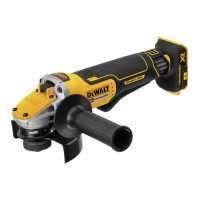11
ENGLISH
NOTE: Edge grinding and cutting can be performed with
Type 27 wheels designed and specified for this purpose;
6.35 mm thick wheels are designed for surface grinding
while thinner Type 27 wheels need to be examined for
the manufacturer's label to see if they can be used for
surface grinding or only edge grinding/cutting. A Type 1
guard must be used for any wheel where surface grinding
is forbidden. Cutting can also be performed by using a
Type41 wheel and a Type 1guard.
NOTE: See the Accessories Chart to select the proper
guard/accessorycombination.
Adjusting and Mounting Guard (Fig. D)
WARNING: To reduce the risk of serious personal
injury, turn tool off and disconnect battery pack
before making any adjustments or removing/
installing attachments or accessories. An
accidental start-up can causeinjury.
CAUTION: BEFORE operating the tool, identify which
guard adjustment option your tool is setto.
Adjustment Options
For guard adjustment, the guard release lever
9
engages
one of the alignment holes
14
on the guard collar using a
ratchetingfeature.
• One-touch
TM
: In this position the engaging face
is slanted and will ride over to the next alignment
hole when guard is rotated in a clockwise direction
(spindle facing user) but self-locks in the counter-
clockwisedirection.
Mounting Guard (Fig. D)
CAUTION: Prior to mounting guard, ensure the screw,
lever, and spring are fitted correctly before mounting
theguard.
1. With the spindle facing the operator, press and hold the
guard release lever
9
.
2. Align the lugs
12
on the guard with the slots
13
on
the gearcasecover.
3. Push the guard down until the guard lugs engage
and rotate them in the groove on the gear case cover.
Release the guard releaselever.
4. To position the guard, rotate the guard clockwise into
the desired working position. Press and hold the guard
release lever
9
to rotate the guard in the counter-
clockwisedirection.
NOTE: The guard body should be positioned between
the spindle and the operator to provide maximum
operatorprotection.
The guard release lever should snap into one of the
alignment holes
14
on the guard collar. This ensures
that the guard issecure.
5. To remove the guard, follow steps 1–3 of these
instructions inreverse.
Flanges and Wheels
CAUTION: Turn unit off and unplug the tool before
making any adjustments or removing or installing
attachments oraccessories.
Mounting Non-Hubbed Wheels (Fig. E)
WARNING: Failure to properly seat the flanges and/or
wheel could result in serious injury (or damage to the
tool orwheel).
CAUTION: Included flanges must be used with
depressed center Type 27/42 grinding wheels and
Type1/41 cutting wheels. See the Accessories Chart
for moreinformation.
WARNING: A closed, two-sided cutting wheel guard
is required when using abrasive cutting wheels or
diamond coated cutting wheels.
WARNING: Use of a damaged flange or guard or
failure to use proper flange and guard can re sult in
injury due to wheel breakage and wheel contact. See
the Accessories Chart for moreinformation.
Depressed center Type 27 grinding wheels must be used
with included flanges.
1. Place the tool on a table, guardup.
2. Install the backing flange
6
on spindle
4
with the
raised center (pilot) facing thewheel. Press the backing
flange intoplace.
3. Place wheel
15
against the backing flange,
centering the wheel on the raised center (pilot) of the
backingflange.
4. While depressing the spindle lock button and with the
hex depressions facing away from the wheel, thread the
locking flange
7
on spindle so that the lugs engage the
two slots in thespindle.
5. While depressing the spindle lock button, tighten the
locking flange
7
by hand or using the wrench supplied.
(Only use a locking flange if it is in perfect condition.)
Refer to Accessory Chart to see flangedetails.
6. To remove the wheel, reverse the aboveprocedure.
9
Fig. D
13
12
14

